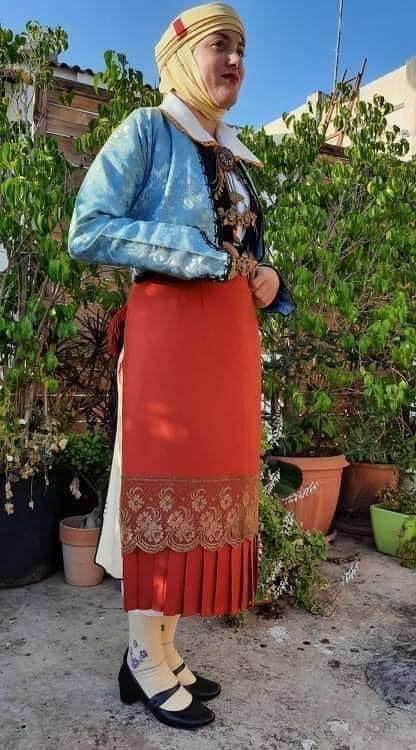Hello all,
Today I will continue my series on Epirus costumes by talking about Pogoni, Πωγώνι, Pogon in Albanian.
This region straddles the current border, with the bulk of it lying in Greece.
https://en.wikipedia.org/wiki/Pogoni
However 7 Greek Speaking villages of this region lie just north of the border in Albania. The two areas are contiguous. This region lies just east of Dropoli, which I talked about in my last article.
https://en.wikipedia.org/wiki/Pogon,_Albania
It is recorded that the costume used to be more elaborate, with a flamboyant headdress that included much jewelry, but that the costume became simplified under the influence of pietism, the women selling their jewelry to pay for churches and schools, with only brides wearing the fancier costumes today. Today's costume is mostly white. Some details of the costume varied from village to village.
Traditionally there is an undershirt, fanela, with fine white embroidery from Constantinople which is worn next to the body.
Over this a chemise, pokamiso, is worn. It is long, opens in the front with long sleeves, The collar, cuffs, and hem were trimmed with natural colored, homemade silk lace, and no other adornment. It has a wide collar which lies open in front. I have not found any images of these two garments.
Silk is raised in this area for local use.
Over this, a sigouni was worn. It had two versions. The dressier version, called sejaci politiko, was made of good quality wool, with dark blue or black bands as well as buttons by the front opening, and trimmed with silk tassels in back.
The everyday sigouni was made of homespun wool, and had no buttons or tassels.
Over the sigouni or sejaci a wide sash, zonari, was worn.
It was 3.25 m long and 35 cm wide, with cords or tassels at each end. It was wrapped 3 times around the waist, arranged so that three of the cords hung down in back, and the rest were tucked under, as we can see in the image below.
The apron, podia, was worn over this sash. The everyday apron was woven in colorful wool stripes.
The festive apron, sajakopodja, is pristine white, of fine quality wool. It is sewn of two fields of cloth, with white silk edging and understated tassels in the center upper and lower edges. It is stored with vertical folds and the creases are visible when worn. Ideally, it was as long as the chemise.
The apron is held in place with a very long, narrow, 10 m x 1 cm, ribbon called zoni.
This was obviously wrapped many times around the waist in a non-overlapping manner so as to form a band perhaps 8 cm wide.
Over this a jacket with narrow sleeves in the Ottoman style, dulamas, was worn. This might be floral or striped, or solid colored.
In some villages, notably Delvinaki, another garment, manikuti siguna, might be worn over this. It resembles the sejaci, but had half sleeves.
On festive occasions, a large buckle, megalo cimeri, might be attached to the zoni.
 |
This might be accompanied by the tsapraci, ornamental brooches which secure the front of the sejaci. Two or three of these might be worn, in various sizes, the smallest at the top, securing the chemise.
At the wedding, a bride would wear two silk kerchiefs hung from the zoni, mandila tis mesis, one on each side. She would continue to wear these for forty days after the wedding, and then wear only one for another two months. Many images feature these.
Traditionally, two pairs of stockings were worn. The first were black, without soles, propodia. Over them white stockings with knitted in designs were worn. Tsarukha were traditionally worn, young women adding pompoms to the toes. Fine red slippers were also worn. Today these are generally replaced with ordinary shoes.
The hair was put into two braids, which were wrapped and tied at the front of the head, ribbons being added if necessary.
Over this the obola is placed. This is a silk scarf which is hand woven, 4m x 25 cm, with narrow red stripes, posi, at each end. It is tightly wrapped around the head four times, with the red stripes at both ends visible.
Here is a tiktok video showing a new bride from Delvinaki getting dressed sometime in the 40 days after her wedding. Notice that her pokamiso has no sleeves.
https://www.tiktok.com/@c.minoa/video/7335414647899655442
Brides wear several more garments and much more jewelry, including a sort of crown. These crowns belong to the parishes, and are borrowed by each bride.
Men wore a costume with vraki, but I have found very few images of the outfit. In Epirus in general, the foustanella was considered to be a luxury garment that few could afford.
Here are some more images of this outfit.
A video of songs and dances from Pogoni.
Thank you for reading, I hope that you have found this to be interesting and informative.
Roman K.
email: rkozakand@aol.com
Source Material:
Angeliki Hatzimichali, 'The Greek Folk Costume vol 1', Athens, 1979
Dr. Gjergji Andromaqi et al, 'Albanian Folk Costumes vol 1', Tirane, 1999
J. C. Mazarakis Aenian et al, 'Greek Costumes', Athens, 1993
Athanasios Khouliaras, 'Paradosiakes Foresies Voreirou Ipeirou', Athens 2022

.png)
.png)
.png)
.png)


















.png)
.png)
.png)

























































Glad to see you again!
ReplyDeletehere one
ReplyDelete